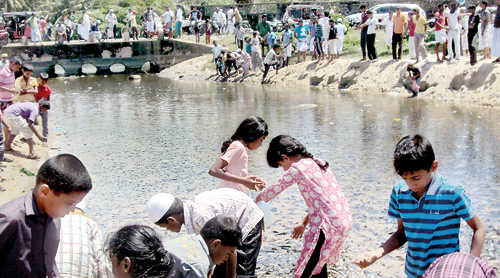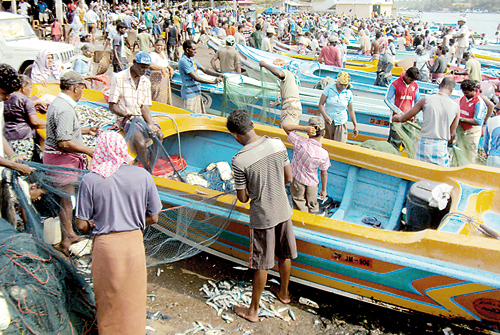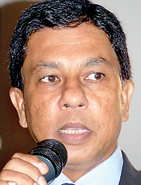News
Seabed change sends thousands of fish ashore
Shoals of fish, some alive and others dead, have begun to flood coastal areas in what experts described yesterday as an impact of the inter-monsoonal weather changes. Thousands of fish were being collected by residents and fishermen in the eastern, southern western, north-western and northern coastal areas and were either being sold or used for consumption.
Health officials and environmentalist said eating this fish was not harmful.

Malu, Malu, Malu: Thousands of fish were washed ashore yesterday due to changes in the weather pattern and the temperature of the seabed. Children and other residents of Beruwala are seen collecting the fish, dead or alive, with experts saying the fish was not harmful for consumption. Pic by S. Siriwardena
K. Arulananthan, head of the National Institute of Oceanography and MarinePlease turn to Page 20
Science of the National Aquatic Resources Research and Development Agency, said samples of the fish had been and the laboratory tests showed there would be no harm in eating the fish.
He said the flood of fish was due to inter-monsoonal weather changes. “During this period there is a change in the temperature of the seabed. This results in the blossoming of algae or microplants that provide more food for small- and medium-sized fish. Since the lifespan of the plants are short they decompose resulting in a shortage of oxygen and drawing the fish ashore,” he said.
Dr. Arulananthan said another reason was that since there was a change in the temperature the small- and medium-sized fish stayed in a zone known as the ‘cold water front’ closer to the shore.
He said the NARA had tested samples of water and the fish and found there would be no harm in eating this fish.
There were fears that the flood of fish was an indication of a tsunami, but that was only a false alarm, he said.
Kattankudy Public Health Inspector R.M. Basheer said he visited the coastal areas and found that people were collecting the dead and live fish.
“I have not got any complaints from the public about any health problems after eating the fish,” he said.
Mr. Basheer, however, said since no officials were coming forward to clean up the beaches, the rotten fish was also remaining in some areas and this was likely to cause a health hazard.
Meanwhile the fish found in the Chillaw, Kalmunai, Karathivu, Addalachenai, Kalady, Kalawanchchikudy, Arugambay and Beruwala are entering the markets in Colombo also.
Follow @timesonlinelk
comments powered by Disqus


























